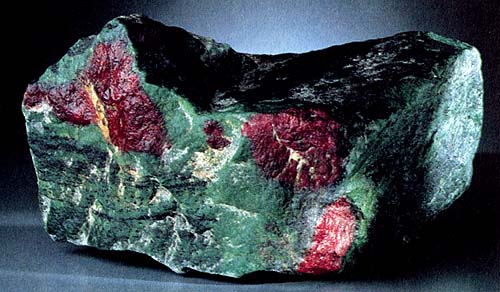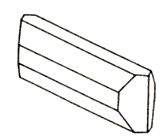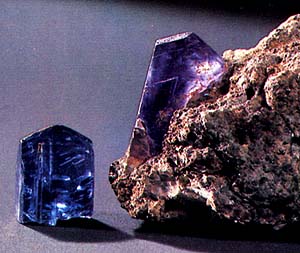Epidotes (silicates): Zoisite (Saualpit)
 Diagnostic card.
Diagnostic card.
On the picture. Two samples of zoisite. Below: tulit.
Ca 2 Al 2 O OH SiO 4 Si 2 O 7
Diamond orthogonality
Hardness 6-6,5
Specific weight 3.15-3.36
Cleavage is perfect
Crack irregular
Color is colorless, white, gray, green, pink.
Color in powder white
Glitter glass, mother-of-pearl

Zoisite is a silicate of aluminum and calcium. Glitter pearl to glass. Opaque. Colors: gray, yellow, greenish, pink (tulit). The line is white. The fracture is uneven. Cleavage is perfect. It is formed in calc-silicate metamorphic rocks. Crystals (rhombic syngony) are rare. More often there are radiant, six-eyed, fan-shaped, large-plate and straw-like aggregates.
 In the composition of this silicate, iron can be present in small amounts. It is represented by elongated-prismatic crystals with imperfect ends; Hatching is observed along the elongation in most crystals. Often there are irregular granules, podular aggregates and lamellar individuals. The color is often absent, but can be white, greenish and pinkish.
In the composition of this silicate, iron can be present in small amounts. It is represented by elongated-prismatic crystals with imperfect ends; Hatching is observed along the elongation in most crystals. Often there are irregular granules, podular aggregates and lamellar individuals. The color is often absent, but can be white, greenish and pinkish.
Chemical composition. Calcium oxide (CaO) 24.6%, alumina (Al2O3) 33.9%, silica (SiO) 2 39.5%, water (H2O) 2.0%. The shape of the crystals. Prismatic; The faces are usually strongly shaded. Class of symmetry. Rhombo - bipyramidal - mmm. Cleavage. Perfect in (010), imperfect with respect to (100). Aggregates. Dense, columnar, radiant, shpatopodobnye.
Mineral zoisite is named after collector Zoiza. It was first discovered in 1805 in Carinthia (Austria) in the Zaualpa ridge; Before the mineral was called zaualpit - in the place of the find and until recently was not considered precious. However, in 1954, a green zoisite rock with inclusions of black hornblende and large, though usually opaque, non-iron ruby crystals was found in the territory of present-day Tanzania. Spectacular color contrasts give this breed a very decorative appearance, which makes it possible to use it as a jewelry and ornamental stone.
In the adverbial tribe of the Massa "annio" means green, from this word one of the breed names - "annolith", the scientific name of the breed, reflecting its composition - zoisite amphibolite is formed. In the 60-70s of the XX century, a sapphire-blue variety of zoisite - tanzanite, as well as jewelery zoisites of other colors and colorless stones was found there.
 A dense pink variety of zoisite is called tulite. Dense dense pink variety of zoisite. It was first opened in Norway (its ancient name is Tul). Recently it was also found in Western Australia and Namibia. It is used as a jewelry and ornamental stone. Externally similar to rhodonite.
A dense pink variety of zoisite is called tulite. Dense dense pink variety of zoisite. It was first opened in Norway (its ancient name is Tul). Recently it was also found in Western Australia and Namibia. It is used as a jewelry and ornamental stone. Externally similar to rhodonite.
The name "tanzanite" was proposed by the jewelry company Tiffany (New York) in honor of Tanzania, the country where there is its only deposit in the world. This is a purely trade name, in mineralogy, it is often simply called "blue zoisite". The stones of good quality have an ultramarine or sapphire blue color. In electric light, it acquires an amethyst-violet shade. When heated to 400-500 o C brownish and yellowish shades disappear and the blue of the stone deepens.
Tanzanite cat's eye is also known. The deposit is represented by veins and cracks with crystals grown in gneisses. In the jewelry market, glass imitations of tanzanite and doublets from glass with a tanzanite upper part or from two colorless synthetic spinels, fastened in both cases with blue glue of "tanzanite" color, appeared on the jewelry market. Tanzanite can be confused with natural and synthetic sapphire.
Diagnostic signs.
Does not lend itself to acids; In the flame of a candle melts, forms a bubble mass. It melts to form a white bubble mass. Behavior in acids. Does not dissolve. Color gray, green, red (tulit).
The version of zoisite, shown in the photo above (annolite), contains in the form of impregnations a non-joule and opaque ruby in green zoisitic rock, which is limited to cabochons or sold in samples. Ruby from zoisitic rocks is not highly valued and is not a jewel stone, although it can be sold expensive.
Origin.
Zoisite is common in igneous rocks, such as gabbros and diorites, where it is formed as a result of changes in the basic plagioclase. In amphibolites, prazinites (which are the result of metamorphic gabbro transformations) and diabases, it is formed as a result of dynamometamorphism.
Place of Birth.
As a component of rocks, zoisite is very common in nature. In the form of individual aggregates of crystals, it occurs in a number of places in the Tyrol and Alto-Adige; In Vipiteno comes a manganese-containing difference of pink color, which is known as tulit, also found in Telemark in Norway. The mineral was first discovered in 1905 in the Austrian Alps. The mountain range where this discovery was made is known as the Zau Alps. A real jewel stone was considered to be zoisite, when beautiful transparent crystals of sapphire blue, violet, greenish-blue were found in Tanzania.

Green zoisite with impregnations of ruby is similar to green jade and garnet demantoid

Green zoisite with impregnations of crimson red ruby (crystal and scattered rubies)
Jewelry quality green zoisite with inclusions of precious stones, Tanzania

Zoisite. Hit-island, North. Karelia, Russia. Photo: © А.А. Evseev.
- Ghetchellit - "New Almaden blend" - arsenide and antimony sulfide (modern sulfosol)
- Antimony is a toxic metal (semimetal) , widely used in metallurgy, medicine and engineering
- Zirconium - a rare and undiscovered metal and the most dangerous precious stone in oxide and salt
- Gold - yellow dangerous and poisonous metal of modern accurate digital and cable technologies
- Sulfur is a golden-yellow toxic substance and a sign of active volcanic activity
- Cadmium is an undisputed toxic silvery metal unknown to a wide range of people
- Lead - a poisonous gray imitator of metallic silver and toxic metal blende
- Arsenic is a classic poison of medieval and modern poisoners and medicine in medicine
Poisonous and radioactive dangerous stones and minerals
** - poisonous stones and minerals (mandatory check in the chemical laboratory + explicit indication of toxicity)
** - radioactive stones and minerals (mandatory check on the standard dosimeter + ban on open sales in case of radioactivity exceeding 24 milli / g / h + additional measures of population protection)
Catalog of minerals and semi-precious stones of the world by groups
** - poisonous stones and minerals
** - radioactive stones and minerals


Comments
Commenting on, remember that the content and tone of your message can hurt the feelings of real people, show respect and tolerance to your interlocutors even if you do not share their opinion, your behavior in the conditions of freedom of expression and anonymity provided by the Internet, changes Not only virtual, but also the real world. All comments are hidden from the index, spam is controlled.